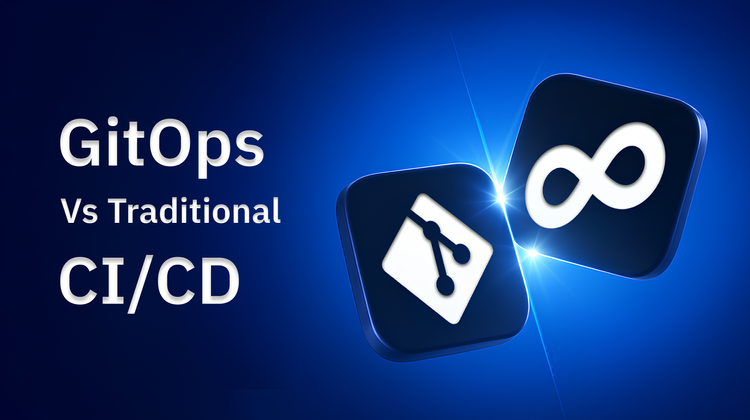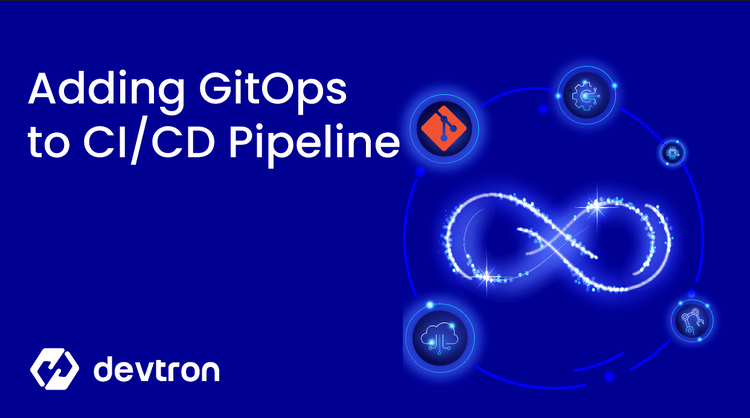1. Argo CD provides a rich web UI, native multi-tenancy, and advanced GitOps for multi-cluster environments.
2. Flux CD is lightweight, CLI-driven, and ideal for resource-efficient or air-gapped deployments.
3. Both tools support GitOps principles, Helm, Kustomize, and deployment strategies like Canary and Blue-Green.
4. Security: Argo CD includes SSO and RBAC, while Flux relies on Kubernetes RBAC.
5. Devtron simplifies GitOps management for both tools
Argo CD vs Flux CD: Quick Comparison Table
| Feature | Argo CD | Flux CD |
|---|---|---|
| Interface | Web UI + CLI | CLI only (unofficial UIs exist) |
| Installation | Simple, Helm for air-gapped support | CLI bootstrap, air-gapped ready |
| Multi-tenancy | Native Projects + RBAC & SSO | Namespace-based, RBAC only |
| Deployment Strategies | Canary, Blue-Green, Progressive (Argo Rollouts) | Canary & Blue-Green (via Flagger) |
| Secret Management | External secrets, SSO support | Relies on Kubernetes RBAC |
| Best For | Enterprise multi-cluster GitOps | Lightweight GitOps in resource-limited setups |
What is Flux CD
Flux CD is an open-source Continuous Delivery (CD) tool that automates Kubernetes deployments using GitOps.
- Declaratively manages Kubernetes manifests stored in Git repositories.
- Provides automated rollbacks and integration with Helm and Kustomize.
- Supports deployment strategies like Canary and Blue-Green via Flagger.
Flux Architecture & Components
Flux comprises multiple controllers:
- Source Controller – Monitors Git repos for changes and triggers deployments.
- Kustomize Controller – Manages resource modifications and dependencies.
- Helm Controller – Handles Helm chart deployments and rollbacks.
- Notification Controller – Sends alerts to Slack, email, or other channels.
- Image Reflector & Automation Controllers – Automatically update manifests when new images are available.
How Flux CD Works
- Developers push updated manifests to the Git repository.
- Flux continuously syncs the cluster state with Git.
- Any mismatch triggers updates using kubectl operations.
- Flux supports air-gapped installations out of the box.
What is Argo CD
Argo CD is a Continuous Deployment (CD) tool widely adopted for Kubernetes GitOps.
- Continuously syncs cluster state with Git repository manifests.
- Offers native web UI, RBAC, SSO, and multi-cluster management.
- Supports Helm, Kustomize, and raw YAML without extra templating.
Argo CD Application Deployment
- Syncs manifests in phases: pre-sync → sync → post-sync to ensure resource health.
- Natively supports multi-cluster deployments and multi-tenancy with projects and RBAC.
- Argo Rollouts provides Canary, Blue-Green, and Progressive Delivery strategies.
Comparison of Flux CD with Argo CD
Both Argo CD and Flux CD are powerful tools for managing Kubernetes deployments. You might be wondering which tool is best for you. Both tools have some key differences from each other. Let us analyze some key differences and similarities between Argo CD and Flux CD:
Installation
ArgoCD and FluxCD are both installed inside your Kubernetes cluster, and they monitor and ensure that the state of the cluster and Git repository are synced. Let's take a look at how the two tools differ in installation.
Argo CD Installation
Installation of Argo CD is relatively straightforward, and all you need to a terminal with kubectl. Installation of ArgoCD involves running two commands. Let's get an understanding of the whole installation process.
The standard installation steps for ArgoCD are as follows:
- Creation of a namespace Argocd and applying the latest ArgoCD release manifest using kubectl. At this point, ArgoCD is installed in the cluster.
- For a hardened CLI user, you can skip installing the UI and can make Argo CD work with just the essential components.
- As an external IP is not configured on the Argo CD API, the user has to configure one to access it from the outside.
- Setting up Ingress is necessary to perform advanced touring and rollback strategies.
- Argo CD wasn't designed to be run in an air-gapped environment, but there are ways to perform air-gapped installations. For installing Argo CD in an air-gapped environment, you will have to use HELM charts.
Flux CD Installation
The Flux CD installation involves downloading and installing the FluxCD CLI utility and bootstrapping the Kubernetes cluster. While bootstrapping the cluster, you need to provide a Git User along with an API token.
Let's take a look at the installation process for FluxCD
- Download and install the FluxCD CLI utility
- Generate an API Token for your Git account. It is recommended to export the values for your API Token, Git username, and Git Repository as Environment variables so it is easy to reuse these values.
- Using the flux bootstrap command, a user can install Flux on a Kubernetes cluster and configure it to manage itself from a Git repository. Flux will create a new directory directly in the Git repository called flux-system, which will be used to store the Flux configurations.
- For an Air-Gapped installation of FluxCD without access to the internet, the FluxCD binaries and the container images need to be downloaded from a system with internet access. Unlike ArgoCD, Flux can run in an offline environment off the shelf.
Manual Cluster Sync
Both tools allow disabling auto-sync for manual control:
- Argo CD: Define syncPolicy: {} and trigger sync via UI or CLI.
- Flux CD: Suspend auto-sync and trigger sync using annotations like:
kubectl annotate --field-manager=flux-client-side-apply --overwrite \
kustomization/podinfo reconcile.fluxcd.io/requestedAt="$(date +%s)"
UI Interfaces
A web-based UI is necessary for most Developers and DevOps teams as business demands them to perform operations faster and with shorter learning curves. Having access to a UI becomes a necessity when teams prefer low-code operations. While a UI adds value to day-to-day operations, it is essential that the UI can provide end-to-end visibility of the system and the proper controls for a better user experience.
ArgoCD Interface
ArgoCD provides a web-based user interface that makes managing and monitoring your deployments easy. The GUI dashboard enables users to perform various tasks, from application onboarding to deployment into Kubernetes clusters, without using the CLI.
Image Source:https://argo-cd.readthedocs.io/en/stable/
If you are looking for a much more advanced dashboard for Kubernetes management where you can perform all Kubernetes applications lifecycle management without using the CLI or kubectl command, explore the Kubernetes dashboard by Devtron.
Flux CD Interface
FluxCD does not provide a user interface and requires you to use the command line interface to manage your deployments. So a user has to rely on the CLI command to manage the deployment lifecycle. This increases the learning curve of using itsFluxCD, making ArgoCD more popular among users.
Devtron has its own Dashboard for listing and gaining visibility into FluxCD and is actively maintained by a team of passionate cloud native developers. Please give manifestsDevtron's FluxCD Dashboard a try if you're looking for a robust FluxCD Dashboard. as
Experimental Flux CD GUI
Image Source: https://github.com/fluxcd/webui
Application Deployment
ArgoCD and FluxCD support Kubernetes objects/which(YAML), Kustomize, and Helm. But both tools are fundamentally different in how they apply those manifests. Let us understand how they differ.
FluxCD for Application Deployment
- FluxCD uses Kustomize Controller heavily, which, performs all the lifecycle operations of Kubernetes manifests of applying the manifests, updating and deleting resources by syncing with the source repository. Without Kustomize, Flux generates its own kustomization.yaml to address dependencies.
- FluxCD also has native support for Helm, which enables it to perform Helm-based releases. FluxCD uses a custom resource called HelmRelease for managing deployments for Helm applications and provides FluxCD with the advantage of using Helm chart libraries from various marketplaces.
- FluxCD can connect to and manage multiple Git repositories using the GitRepository custom resource. For multi-cluster deployments, FluxCD used the Hub and Spoke architecture. One Hub cluster will have the FluxCD installation, and the other clusters (spokes) can be managed from the Hub.
flux get kustomizations --watch
Watch for the synchronization process
ArgoCD for Application Deployment
- ArgoCD has Kustomize, Helm, and raw Kubernetes YAML. While FluxCD needed Kustomize to modify manifest files, Argo doesn't need to use Kustomize. It can perform deployments without a Kustomoize template and can sync resources directly from raw YAML manifests. But this sometimes creates an issue of sequencing builds, and some apps may fail to start because their resources aren't yet available.
- Though it may seem counterintuitive, its creators made this architecture such as to exercise far greater control over its resources. ArgoCD performs sync operations in a sequence of steps and is broadly classified into three phases: pre-sync, sync, and post-sync. The sequencing allows ArgoCD to ensure resources are healthy before syncing subsequent resources.
- ArgoCD also has native support for Helm, but the approach for application deployment is different. While Flux uses the Go library directly, Argo uses the Helm charts and converts them into ArgoCD sync waves and hooks. This internal configuration prevents users from using the HELM CLI for clusters.
- ArgoCD provides far more valuable capabilities for multi-cluster management. It can connect multiple Git repositories to one cluster and can manage multiple clusters from one ArgoCD instance
Image Source: https://argoproj.github.io/cd/
Multi-Tenancy
Flux CD
- Uses namespaces and RBAC for isolation.
- Platform admins install & manage Flux; tenants get namespace-limited access.
Argo CD
- Supports projects for logical isolation.
- Offers cluster-scoped or namespace-scoped installations.
- Native RBAC & SSO enable secure multi-tenancy.
Deployment Strategies
- Argo CD: Canary, Blue-Green, Progressive (via Argo Rollouts).
- Flux CD: Canary & Blue-Green (via Flagger).
- Both support traffic splitting with Istio, NGINX, Traefik, and AWS App Mesh.
Security Considerations
- Both tools follow Git as the source of truth, but secrets should be external.
- Argo CD: Native SSO and internal RBAC.
- Flux CD: Relies on Kubernetes RBAC.
Conclusion
Both GitOps tools are highly capable:
- Flux CD is perfect for teams needing a lightweight, CLI-first solution.
- Argo CD shines with UI, multi-cluster management, and enterprise security features.
FAQ
Which is better: Argo CD or Flux CD?
Argo CD is better for enterprise, multi-cluster, and UI-driven GitOps. Flux CD is lighter and CLI-focused.
Can Argo CD and Flux CD be used together?
Yes, but teams typically choose one based on complexity and resource requirements.
Which tool is better for air-gapped environments?
Flux CD is simpler for offline environments; Argo CD requires Helm for air-gapped setups.
How does Devtron simplify GitOps?
Devtron provides a unified dashboard for Argo CD and Flux CD, reducing CLI complexity.








